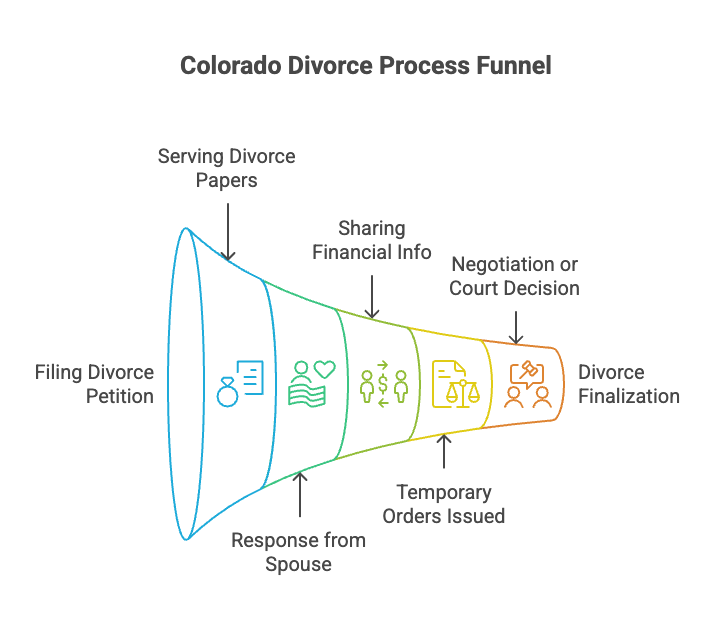- Why Colorado's No-Fault Divorce System Just Makes Sense
- The Grounds for Divorce in Colorado (It's Simpler Than You'd Think)
- Walking Through the Colorado Divorce Process (Step by Step)
- Uncontested vs. Contested Divorce: What's the Difference?
- Why Having the Right Counsel in Your Corner Changes Everything
- Your Family. Your Future. Start Here.
We Choose Sides. Yours. Protecting Your Family, Your Rights, and Your Future.
Why Colorado’s No-Fault Divorce System Just Makes Sense

Let’s be honest—nobody walks down the aisle thinking about how to navigate divorce laws someday. Yet, life is unpredictable. If you’re reading this, you might be facing one of those pivotal crossroads. I want you to know upfront: Colorado’s approach to divorce is actually designed to make this challenging chapter a little easier.
So, what exactly is a “no-fault divorce,” and how does it work in Denver? In a nutshell, you don’t need to dig through your relationship history in search of blame or prove to the court that someone “did something wrong.” If you simply believe that your marriage can’t be fixed—that’s enough. Compared to states that still require proof of fault (think: infidelity, abandonment, etc.), Colorado’s system is far more focused on moving forward than assigning blame.
The Grounds for Divorce in Colorado (It’s Simpler Than You’d Think)
Let’s clear up a common misconception: you don’t need a laundry list of grievances to start the divorce process here.
The basic requirement? One of you must state that the marriage is “irretrievably broken.” That’s it. No need for big, dramatic explanations. In legal speak, this is called “irreconcilable differences.” For many, there’s a certain relief in knowing private matters stay, well, private.
You also might have heard rumors about mandatory separation periods. Here’s the breakdown:
- Residency: At least one spouse needs to have lived in Colorado for 91 days before filing.
- Waiting Period: Once the paperwork is filed and officially served, there’s a 91-day waiting period before things can be finalized.
So, while you don’t need to live apart before filing, a little patience is still required during the official waiting period. If you’ve just moved to Denver, mark your calendar and take a breath—you’ll need to be a resident for that first chunk of time.
Walking Through the Colorado Divorce Process (Step by Step)
Now, let’s break down the actual process. It might look intimidating at first glance, but once you see it step-by-step, it’s not quite so overwhelming.
1. Filing the Divorce Petition
One person takes the first step by filing what’s called a “Petition for Dissolution of Marriage” with the court in the county where at least one of you lives.
2. Serving the Divorce Papers
After you file, the other spouse has to be officially notified—this is known as “being served.” It can be done through a process server, a county sheriff, or (if things are amicable) by signing a waiver. I’ve seen couples who even hand the papers to each other over coffee—sometimes it really does happen that way.
3. The Response
The receiving spouse has the right to respond—usually within 21 days for Colorado residents (or 35 days if they’re out-of-state).
4. Sharing Financial Info (“Discovery”)
Both sides need to lay all cards on the table financially. This might feel uncomfortable, but it’s key to reaching fair decisions about property, debts, and support. This open-book policy is designed to protect everyone involved.
5. Temporary Orders
During the divorce, the court can issue “temporary orders” for immediate guidelines. These orders might specify who remains in the family home, temporary custody schedules, household bills responsibility, or temporary child support and alimony until finalization.
6. Negotiation, Settlement, or Court
With all the details on the table, you’ll work with your attorneys (and sometimes mediators) to try for a fair settlement. Most cases actually settle before trial. But if you and your spouse can’t agree, a judge will step in to decide.
If you’re worried all this sounds complicated or confusing, you’re not alone. I’ve met so many people who feel lost until someone walks them through these steps in plain English. That’s exactly why we take the time to make things clear every step of the way.

Uncontested vs. Contested Divorce: What’s the Difference?
This is a question we hear almost every week: “What’s the difference between uncontested and contested divorce? And which is better for me?”
Let’s break it down:
Uncontested Divorce (The Smoother Path)
If you and your soon-to-be-ex agree on all the big stuff—property, debt, custody, alimony—then you’re in “uncontested” territory. Here’s why many folks aim for this outcome:
- It’s faster (less time in limbo means more time moving ahead)
- Lower legal costs (no endless court battles)
- Less stress (honestly, life’s hard enough already)
Uncontested divorces are a bit like agreeing to terms before shaking hands—less drama, fewer unknowns. Not everyone can take this route, but if you’re close to an agreement, mediation can help bridge those last gaps.
Contested Divorce (When You Can’t Quite Agree)
If one or both of you disagree about major issues, the divorce becomes “contested.” Don’t worry—contested doesn’t mean all-out war (despite what TV might suggest). Sometimes it’s just a matter of needing extra help to work through complicated property or custody questions.
- You might have a hearing or trial.
- The judge may need to make decisions for you.
It’s normal to feel nervous if your divorce is contested. Emotions run high, especially when kids or high-value assets are on the line. The right legal support will help you cut through the noise, prioritize what matters, and keep your future protected.
Mediation & Collaborative Divorce: More Options
Maybe you like the idea of sorting things out without a judge deciding everything. That’s where mediation and collaborative divorce come in.
- Mediation: A neutral third party helps you and your spouse negotiate.
- Collaborative Divorce: Both of you and your lawyers commit to working things out together, outside the courtroom.
We’ve seen tremendous success helping clients resolve tough issues through these methods—sometimes even when they thought they’d never agree on anything.

Why Having the Right Counsel in Your Corner Changes Everything
We won’t sugarcoat it—divorce can be tough, confusing, and more than a little bit emotional. You’re probably worrying about the kids, your home, finances, and what life will look like on the other side. That’s completely normal.
Founded and led by Managing Attorney April D. Jones, a recognized authority in Colorado family law with over 30 years of legal expertise, Jones Law Firm has successfully guided clients through more than 4,000 divorce cases statewide. Our extensive track record provides unmatched expertise, strategic insight, and peace of mind. Working with Denver Divorce Attorneys at Jones Law Firm means you never have to go it alone—or in the dark.
For example, one recent client shared:
April Jones has represented me very well in my family court case. April always valued how I felt and what I wanted the outcome to be for the case. She understood my concerns and made sure they were kept on the forefront. I feel my cases outcome was positive for me and my family because of that. Thank you.
M.C. – Denver Client
We Choose Sides. Yours. When your family’s future matters most, having the right advocate really does make the difference.
Thinking about your next step? That’s why we’re here. Reach out for a confidential consultation. Let’s put a plan together that gives you clarity, peace of mind, and a clear path forward.
This information is meant as a helpful overview—your situation is unique, and we’re happy to answer your specific questions directly. If you’re ready for trustworthy advice and an advocate in your corner, connect with a trusted Denver divorce attorney at Jones Law Firm today. You don’t have to navigate this alone.
Your Family. Your Future. Start Here.
Did this article spark more questions, or maybe just a tiny bit of relief? Either way, that’s exactly why we do what we do. Divorce doesn’t have to leave you lost. And with the right guide, the future gets brighter—step by step.
